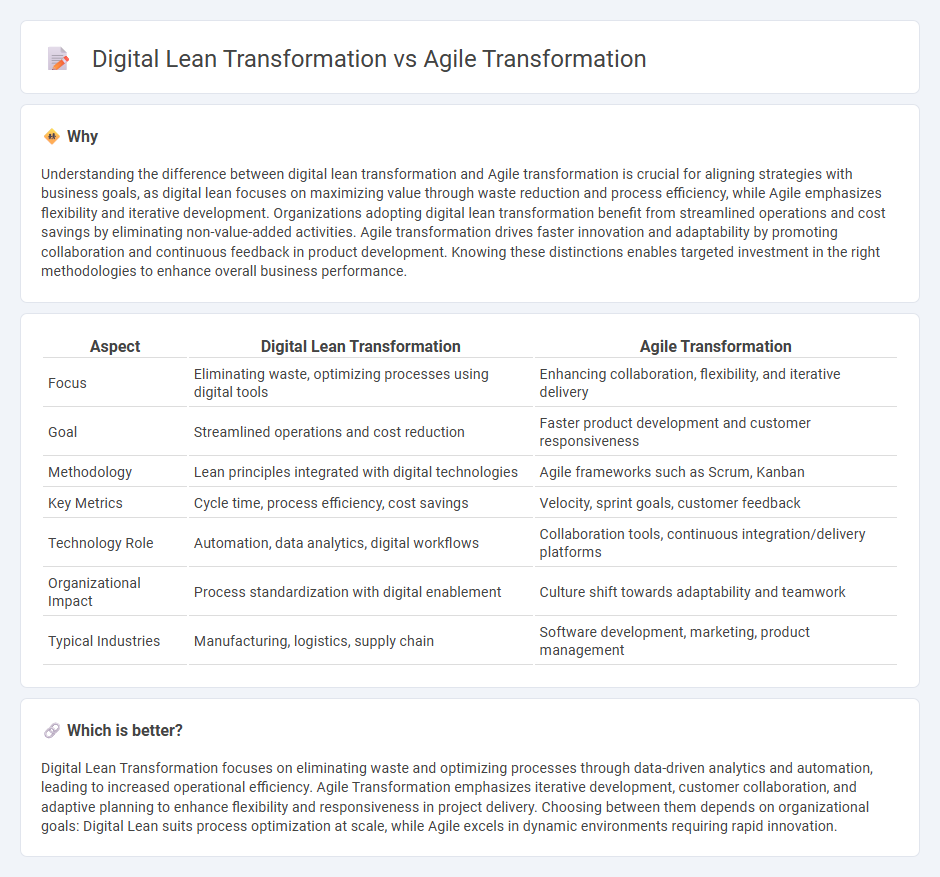
Digital lean transformation streamlines processes by eliminating waste and maximizing value through continuous improvement and customer-centric strategies. Agile transformation emphasizes iterative development, cross-functional collaboration, and adaptability to change in fast-paced environments. Explore how these methodologies can revolutionize your business agility and efficiency.
Why it is important
Understanding the difference between digital lean transformation and Agile transformation is crucial for aligning strategies with business goals, as digital lean focuses on maximizing value through waste reduction and process efficiency, while Agile emphasizes flexibility and iterative development. Organizations adopting digital lean transformation benefit from streamlined operations and cost savings by eliminating non-value-added activities. Agile transformation drives faster innovation and adaptability by promoting collaboration and continuous feedback in product development. Knowing these distinctions enables targeted investment in the right methodologies to enhance overall business performance.
Comparison Table
| Aspect | Digital Lean Transformation | Agile Transformation |
|---|---|---|
| Focus | Eliminating waste, optimizing processes using digital tools | Enhancing collaboration, flexibility, and iterative delivery |
| Goal | Streamlined operations and cost reduction | Faster product development and customer responsiveness |
| Methodology | Lean principles integrated with digital technologies | Agile frameworks such as Scrum, Kanban |
| Key Metrics | Cycle time, process efficiency, cost savings | Velocity, sprint goals, customer feedback |
| Technology Role | Automation, data analytics, digital workflows | Collaboration tools, continuous integration/delivery platforms |
| Organizational Impact | Process standardization with digital enablement | Culture shift towards adaptability and teamwork |
| Typical Industries | Manufacturing, logistics, supply chain | Software development, marketing, product management |
Which is better?
Digital Lean Transformation focuses on eliminating waste and optimizing processes through data-driven analytics and automation, leading to increased operational efficiency. Agile Transformation emphasizes iterative development, customer collaboration, and adaptive planning to enhance flexibility and responsiveness in project delivery. Choosing between them depends on organizational goals: Digital Lean suits process optimization at scale, while Agile excels in dynamic environments requiring rapid innovation.
Connection
Digital lean transformation and Agile transformation are interconnected through their shared focus on enhancing organizational efficiency and responsiveness by eliminating waste and fostering continuous improvement. Both methodologies emphasize iterative processes, cross-functional collaboration, and customer-centric value delivery to accelerate innovation and adapt to market changes swiftly. Implementing Agile frameworks within digital lean initiatives enables real-time feedback loops and flexible adjustments, driving faster, more sustainable business transformation outcomes.
Key Terms
Iterative Development (Agile transformation)
Iterative Development in Agile transformation emphasizes continuous delivery, customer feedback, and adaptive planning, fostering flexibility and faster value realization. This approach contrasts with Digital Lean transformation, which prioritizes waste reduction and process optimization across digital workflows. Explore the nuances between these methodologies to better align your transformation strategy.
Value Stream Mapping (Digital lean transformation)
Value Stream Mapping (VSM) in digital lean transformation emphasizes identifying and eliminating waste to optimize end-to-end workflows, enhancing both digital processes and customer value delivery efficiently. Agile transformation prioritizes iterative development and team collaboration but may not deeply analyze entire value streams beyond software delivery cycles. Explore how integrating VSM into your transformation strategy drives continuous improvement and maximizes value creation.
Change Management
Agile transformation emphasizes iterative processes and adaptability, enabling teams to respond quickly to change and continuously deliver value through effective change management strategies. Digital lean transformation integrates lean principles with digital technologies to streamline workflows, reduce waste, and enhance productivity by fostering a culture of continuous improvement and stakeholder engagement. Explore our comprehensive guide to understand how change management drives success in both Agile and digital lean transformations.
Source and External Links
Agile Transformation: The Guide to Getting Started - Agile transformation involves building leadership support, defining an end-state vision, creating a roadmap with incremental delivery, and progressively changing organizational structure and governance to enable regular, tested software releases.
What is Agile Transformation? | Definition and Overview - ProductPlan - Agile transformation is the process of shifting an entire organization to agile principles, emphasizing cross-functional teams, continuous coaching, iterative process improvements, and cultural change, often starting with pilots before company-wide rollout.
What is Agile Transformation? Types, Benefits, and Six ... - Aha.io - Agile transformation requires coordinated change across areas like learning culture, team adaptability, iterative workflows, adoption of enabling technology, customer collaboration, and data-driven performance tracking to sustain agility over time.
 dowidth.com
dowidth.com